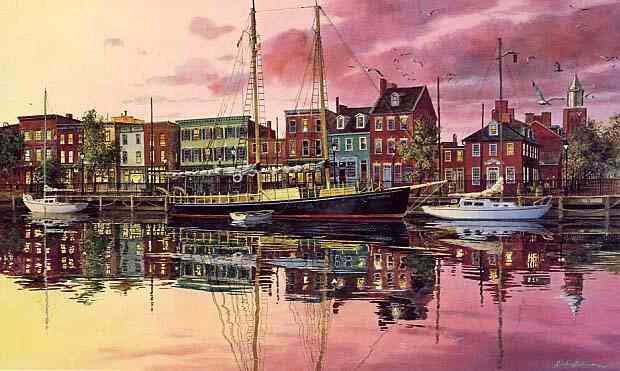The Wharf Rat, on the corner of Ann and Lancaster, is a picture-perfect nautical bar. Far from the warfare of faux-iconography that assaults you at a Joe's Crab Shack, the colors here look like they were probably bright at some time but subdued now, faded by salt water air and further darkened by the establishments' apparent distaste for any light brighter than a lantern. On the walls, paintings of ships and their captains accompany wooden mermaids and tarnished brass, all dusted with history.
The history gets dustier on stormy nights when the inevitable power failure causes the bartenders to break out the candles. That's as good of a time as any for this story.
In 1807, Great Britain was at war with France so they naturally imposed trade restrictions. As the Brits were fresh off the American War for Independence and probably had a problem with that, they decided to stop United States merchant ships right off the coast of Maryland and tell the seamen on board to get to work for His Majesty. This rightly pissed off a bunch of people who had gained all of their power and money from shipping things. Well, few places had more of those very pissed off rich people in power than Baltimore. So, the U.S. declared war on Britain in 1812.
I might be simplifying it a little but I've got a point to get to. Read more here.
Right away, the British Navy realized that Baltimore, specifically Fell's Point, was second only to Tortuga for skilled and morally degenerate sailors. Even worse, these salty dogs had been given a license to capture foreign vessels by the U.S. Government, which gave angry business owners a legal right to fund the privateers into going straight gangster. Even worse? These privateers had a personal hatred for the British Navy so it wasn't all, "Ahoy mately! Pony up all yer booty! Thanks a lot and we'll see ye around..!"
 |
| ..."see ye around Davy Jones' f'n Locker, we will." |
In September of 1814, the Brits headed to Fell's Point for a party. A landing party. They planned to sail right into the harbor and capture that "nest of pirates".
 |
| The difficulty of which largely depends on how drunk they are. |
A month later, a Baltimore actor sang Key's song in a D.C. bar and by November it was a bonafide hit. For the next 80 or so years, "Defence of Fort McHenry" was to Independence Day what Paul McCartney's "Wonderful Christmastime" is for us in December today.
 |
| By week two, just hearing the opening synthesizers makes my heart shrink two sizes too small. |
On a quiet morning, there was just one customer in the tavern and he was just about done hearing about how broad the stripes and bright the stars were. He told the landlord to stop playing that damn song or he was going to come back with his brother, and a gun, and kill him. Turning up the volume a little more, the landlord continued to sweep out the huge fireplace in the back, pretty much telling the customer if he didn't like it, he could move to England.
In a surprising turn of events for a hundred-plus-year-old story about a heated argument that took place in a seedy bar, the drunk customer went out, got his brother, got a gun, and shot the landlord dead, right inside the front door.
 |
| Right where the oddly out of place British telephone booth stands today. |
Next time you visit the Wharf Rat, head to the back, past the second bar where the argument took place, and check out the huge fireplace. It's still lit during the coldest months and, if the bartenders haven't cleaned up the ash, there'll be boot prints tracking through it.
If not, just order a drink, have a seat nearby, and wait. Because there will be.





